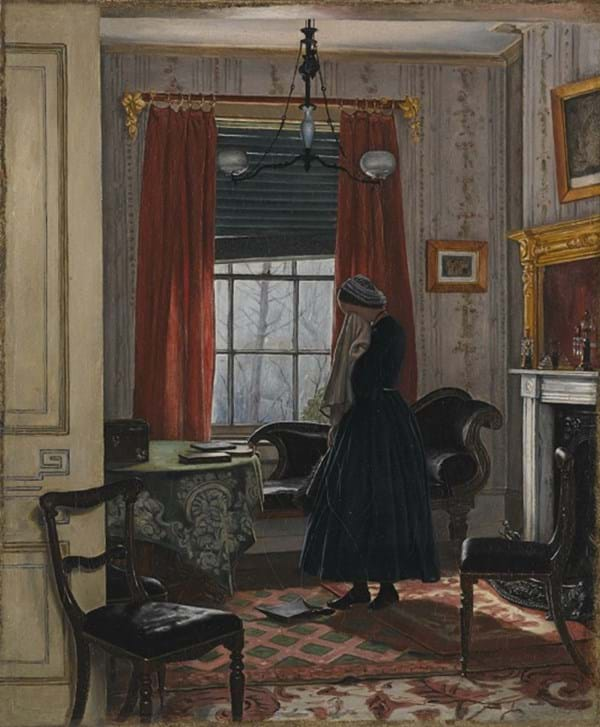Getting comfortable
A warm house, a comfy chair, a well-lit room – lots of things make our homes comfortable places to be.
Over time, as society has changed, so has our idea of comfort.
Technological advances, affordable furniture, domestic behaviours, heating and lighting have all impacted the comfort of our homes.

'Little reminders'
JMc admits that her home is an impersonal place, but a pinboard in her room full of photographs and memories brings her comfort.
'I think it's important to have little reminders, photographs of families, some birthday cards… It tears me up when I look at it, and it makes me feel a bit more like it’s a home as opposed to just a place that I sleep.'
JMc and her boyfriend rent a room in a house they share with eight other people. She has never met the landlord and rarely sees her housemates.
Shared house, JMc, 2014. Part of our Documenting Homes collection


'Not desperately comfortable'
'It doesn’t feel like it's quite home, because it's not desperately comfortable here. I suppose I just sort of like fixing stuff and making stuff. It's kind of more like a shed than a home.'
Wandering around London one day, Jake stumbled across a warehouse in a dead-end mews.
Immediately intrigued, he tracked down the owner to negotiate a price on the derelict property, which had no roof, heating or hot water.
Jake has now renovated the warehouse, but admits it is still an uncomfortable place to live.
The fixer-upper, Jake David Secombe, 2004. Part of our Documenting Homes collection

Jean
'Ralph died 14 February 2006. I think I've aged a year for every month since he died. He used to do the garden. Sometimes I sit here and I can visualise him going out to the shed.'

Mavis
'My daughter gave me that cherry tree as soon as we came here and now it's over thirty years old. All my friends give me different things for my garden from different places.'
Hackney elders
In 2007, photographer Sophie Verhagen met a group of Hackney elders through a gardening project managed by Anchor Trust.
The people she photographed found great solace and comfort in their gardens, but struggled to maintain them in old age. Her intimate portraits are a reminder of the love, reward and frustration gardens can create.

Smoking in the parlour
After a long day, coming home and settling into your favourite chair can be incredibly satisfying. The figure relaxing in this painting may have just returned from the races – he has mud on his boots and a book called 'The Turf' lies on the table to the left.
The man looks comfortable but his pose and behaviour would not have been considered respectable during the Victorian period. Smoking in the parlour was frowned upon and his red face and discarded tankard suggests he may have overindulged at the races.
Interior of a parlour, John Soden, 1862, oil on canvas


The First Place
In this painting a maid stands in tears in the middle of a room, her dustpan dropped to the floor. She is overcome with the difficulties of her ‘first place’ in a job away from her home and family.
In the 1800s the majority of servants were young women working in small households, often alone. They worked hard, sometimes 16 hours a day, with little time off. Servants lived with the families they worked for, but were often hidden from view.
Home is a place where we might experience both positive and negative relationships, love and loss. These experiences can build or disrupt our sense of comfort and belonging.
Purchased with the assistance of the Art Fund and the Museums, Libraries and Archives Council/V&A Purchase Grant Fund.
The First Place, by A Erwood, exhibited in 1860, oil on canvas
 © Kyna Gourley
© Kyna Gourley
Pink v black
For Ranae, home is 'a place where you can just feel comfortable. Where you don’t feel like people might judge you. Or look at you in a funny way cos it's home'.
When Ranae's bedroom was being redecorated she wanted all the walls black, but her mother loves pink. Eventually, the pair compromised and Ranae was allowed to paint a black feature wall among the pink. The colour scheme is an eclectic mix of both styles, but Ranae doesn't mind.
Teenage bedroom, Ranae, Kyna Gourley, 2013. Part of our Documenting Homes collection

Scoop chair
Scoop's form reflects the informal and relaxed style of furniture that we expect in today's homes, where lounging is an everyday part of getting comfortable.
Low to the ground and unusually shaped, it would have been almost impossible to sit up straight in this chair.
'Scoop' was designed by Terence Conran and sold by Habitat from 1974 to 1980. Each chair was made from a solid block of upholstery foam that was scooped out to form a seat. The seat and cushion were then covered in a corduroy fabric called 'Groovy'.
Scoop designed by Terence Conran, for Habitat, 1974–1980, corduroy and Acro Foam

Easy chair
In the early 1700s, this easy chair would have been the height of comfort. Fully upholstered, its high back protected its sitter from cold draughts and its wings were perfect for napping. Chairs like this were expensive and would generally have been reserved for the old or the sick.
Although faded, the upholstery on this chair is original, making it an exceptionally rare example of early Georgian furniture. If you look closely, patches of fabric on the inside of the arms still retain some of their original green colour.
Purchased with the assistance of the Art Fund and the V&A Purchase Grant Fund.
Easy chair, 1720–1740, walnut, beech and wool


Armchair
Low armchairs like this one were associated with women as they were moderately comfortable, but still allowed you to sit with a refined posture. It was a welcome compromise for women who still had to endure tightly laced corsets in the name of elegance.
In the Victorian period furniture was considered either masculine or feminine. For many men comfort came before elegance, and upholstered chairs were expected to be comfortable. For many women, however, elegance took priority.
Armchair, about 1890, mahogany, birch and cotton
